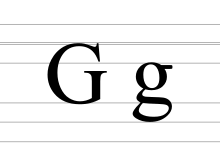| G | |
|---|---|
| G g | |
 | |
| Usage | |
| Writing system | Latin script |
| Type | Alphabetic |
| Language of origin | Latin language |
| Sound values | |
| In Unicode | U+0047, U+0067, U+0261 |
| Alphabetical position | 7 |
| History | |
| Development | |
| Time period | ~−300 to present |
| Descendants | |
| Sisters | |
| Transliterations | C |
| Other | |
| Associated graphs | gh, g(x) |
| Writing direction | Left-to-right |
| ISO basic Latin alphabet |
|---|
| AaBbCcDdEeFfGgHhIiJjKkLlMmNnOoPpQqRrSsTtUuVvWwXxYyZz |
G or g is the seventh letter of the Latin alphabet, used in the modern English alphabet, the alphabets of other western European languages, and others worldwide. Its name in English is gee (pronounced /ˈdʒiː/), plural gees.[1]
The lowercase version can be written in two forms: the single-storey (sometimes "opentail") ![]() and the double-storey (sometimes "looptail")
and the double-storey (sometimes "looptail") ![]() . The former is commonly used in handwriting and fonts based on it, especially fonts intended to be read by children.
. The former is commonly used in handwriting and fonts based on it, especially fonts intended to be read by children.
- ^ The American Heritage Dictionary of the English Language. 1976.
